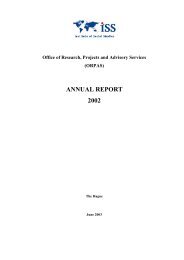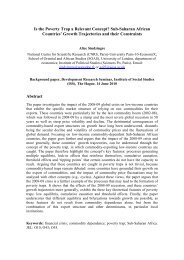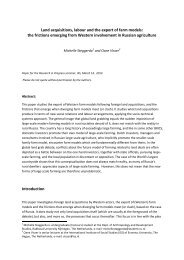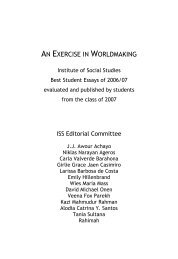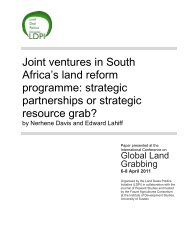AN EXERCISE IN WORLDMAKING 2009 - ISS
AN EXERCISE IN WORLDMAKING 2009 - ISS
AN EXERCISE IN WORLDMAKING 2009 - ISS
You also want an ePaper? Increase the reach of your titles
YUMPU automatically turns print PDFs into web optimized ePapers that Google loves.
108 BERNICE CAMPOS ROLD<strong>AN</strong><br />
ports the concerns raised over ‘the high cost of capacity building and the<br />
poor record of continued utilization of skills gained in vocational training<br />
programs’. Difficult choices would have to be made in order to maximize<br />
resources, but again, in choosing between modifying the client and<br />
environment, or modifying the service, it is critical to be guided by the<br />
logic of the poor and the dynamics of poverty if we seek to better include<br />
them in program interventions.<br />
CONCLUSION: SOLUTIONS <strong>AN</strong>D TRADE-OFFS<br />
In revisiting the microfinance for poverty alleviation debate, this paper<br />
compared and contrasted the research contributions and perspectives of<br />
various authors, and placed emphasis on those that examined the phenomenon<br />
through the lenses of self-help, gender and targeting. To challenge<br />
the suitability of the ‘one size fits all’ model of microfinance in<br />
reaching out to the poorest, this paper presented case studies and innovations<br />
targeting the very poor. Conscious attempts were made to present<br />
both ‘hits and misses’ in the literature. Studies indicate that just as<br />
no perfect targeting mechanism exists, no perfect microfinance model<br />
for the poorest seems to exist either. It is evident that solutions come<br />
with their accompanying trade-offs, so it is critical to take the context<br />
into account when employing microfinance strategies for poverty alleviation.<br />
In closing, this paper highlights the need to put development back<br />
into microfinance, to tailor it as a poverty alleviation instrument more<br />
than a profit-making enterprise. This requires not only the poor going<br />
through change in the process. Credit programs, MFIs, policy-making<br />
institutions and international development agencies should be reformed<br />
as well, bearing in mind the capacities of the poorest and the dynamics<br />
of poverty. Microfinance for poverty alleviation is more than a technical<br />
activity. Making tough choices between approaches of targeting and program<br />
design, or between the comprehensive and minimalist approach in<br />
microfinance, or questioning our assumptions in development – these<br />
are clearly political acts as well. It is critical for those designing, implementing,<br />
monitoring or funding program interventions to seriously attempt<br />
to prevent the poorest from falling under the radar.




